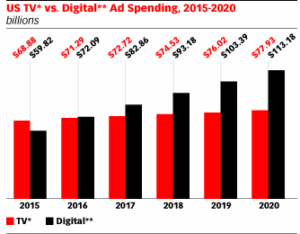“Google Preferred”: from Cat Videos to Premium Content

The launch of Google Preferred was game-changing, shifting Billions from TV to Digital.
TV Advertising. We all enjoy it. Think about your favorite Super Bowl ad. Which one was it? Over the years, TV advertising has graced us with many great commercials and moments.
However, TV advertising dollars are rapidly going Digital. This year, for the first time ever, US Digital spend will exceed TV spending. By the end of the year, this digital spend will reach $72 Billion, while TV spend will grow to only $71 Billion [1]. And this gap will continue to get exponentially wider and wider in the future.
There are many reasons for Digital’s success in capturing advertising market share (the growth of Mobile, the ability to bid on ads in real time, etc..), but today I instead want to focus on the biggest challenge facing online video Advertising, and how Google overcame it – to become the dominant player in online advertising.
The Online Advertising Challenge: Premium Inventory
Close your eyes and imagine you are the marketing executive for a large Retail Brand. I’m serious, close your eyes and play along.
How are you planning on spending your marketing budget? TV advertising probably comes to mind. But why TV? Well, there’s the benefit of reach – you want people to actually see your ads, right? But “reach” isn’t the reason, if it was the reason, you’d be quick to spend all your advertising dollars on YouTube, where almost 5 billion videos are watched on every single day, by nearly 1.3 Billion people [2].
I’ll cut to the chase: Advertisers have historically loved spending on TV because of their ability to show their ads on premium inventory. Remember that Super Bowl ad I asked you about earlier? Well, Super Bowl advertising is the cream of the crop of premium inventory.
Up until 2014, there was no large scale way to get this kind of premium inventory online. And, up until 2014, TV advertising was still bigger than Digital…but not for long.
Enter Google Preferred
In true Willy Shih fashion, I’ll summarize “Google Preferred” in 25 words: Google Preferred allows advertisers to place their ads on the top 5% of YouTube inventory, for a slightly higher cost. That was 20 words, not bad.
With the launch of Google Preferred in 2014, advertisers now had the ability to show their ads exclusively on YouTube’s most popular channels, along-side the hottest or viral videos of the time, and narrowly target their audience [3].
While previously, if you wanted to run your ad on premium US inventory, your only option was to write a not-so-little $5M check for a 30-second Super Bowl ad [4], and hope that your target audience was watching. Now advertisers have more flexibility and control. They can divert that $5M check to YouTube, and hyper-target the most premium inventory in the digital space.
- You want to target those 18 year-old gamers, watching those viral Video Game videos on YouTube? You Got it!
- You want to target those 20 year-old females that love watching YouTube Beauty and Fashion blogs? You got it!
The beauty of Google Preferred was simple: offer advertisers the one thing TV executives used as their main selling point– premium inventory.
“Google Preferred” Success
Advertisers and agencies flocked to Google Preferred in high numbers, so much so that Google Preferred inventory sold out in a few short months. And to this day, advertiser Demand continues to far exceed Supply of inventory, with many agencies committing upwards of $250 Million on Google Preferred [5]. That’s the equivalent of 50 Super Bowl ads cost!
Going Forward
Yes, you can now run your ad on the most popular YouTube Videos. However, there’s still some work to be done: Not all advertisers are able to buy Google Preferred – there’s a very long waiting line. Yes, it is a good problem to have when Demand exceeds Supply, but you’re also leaving money on the table (if you’re Google).
Google needs to get more premium content to satisfy this demand. How do they get more premium inventory – by having more YouTube producers. There’s a strong demand for viral YouTube videos, and if Google can convince more artists and producers to create this content on their platform, then their future looks even brighter.
Excuse me as I now log into YouTube to watch a cat use a toilet.
[1] https://www.emarketer.com/Article/US-Digital-Ad-Spending-Surpass-TV-this-Year/1014469
[2] http://fortunelords.com/youtube-statistics/
[3] http://variety.com/2014/digital/news/youtube-unveils-google-preferred-at-newfronts-event-1201168888/
[4] http://fortune.com/2015/08/06/super-bowl-ad-cost/
[5] http://www.wsj.com/articles/interpublic-to-shift-250-million-in-tv-ad-spending-to-youtube-1462359623




Thanks for such a fascinating post – I had never heard of Google Preferred and was amazed to hear how digital spending will exceed TV spending this year. This is a question for all digital marketing efforts, but how do you think Google can maintain net neutrality in this business model? How would Google deal with a situation where say, a presidential ad (e.g. Trump) is at the top 5% of Youtube inventory, and another presidential candidate (e.g. HRC) or a company at odds with Trump’s policies, buys a premium advertising space? Would they show such ads with such a video? How would Google allocate its ad space among Preferred advertisers?
This is really interesting, Jose– I did not know about Google Preferred either but the business model makes complete sense.
I like the Preferred model because it is harnesses the power of the free market. Consumers act as a pull for producers to create more premium content of a certain genre (let’s use fashion blogs as an example). Through Google’s analytics, fashion bloggers can respond to exactly what the market wants in the quantity that it wants it– 100k views on lipstick color or 1M views on shoe choice? For the digitization it enabled, Google is rewarded through higher or lower ad revenues. Ultimately, this system is beneficial for all as consumers get exactly what they want (demand fulfillment), real-time, transparent feedback through views and comments lets the fashion bloggers know how much and what to produce (no wasted inventory, little bullwhip effect), and Google charges advertisers fair value for a given customer base (value capture).
While I had not heard of Google Preferred prior to this article, the concept absolutely makes sense. Allowing companies to target particular consumer segments is extremely valuable, and can be tapped to in an even more direct way than television ads. However, I do think that there is even more money being left on the table than just limited supply of YouTube videos. At this point, gmail is one of the most preferred forms of email, and is often used as a form of login information for other websites. With this being said, Google likely has significant user trend data to identify what particular customers’ preferences and tendencies are, on sites outside of YouTube as well. While it may seem to be an infringement on consumer privacy, if they are already willing to sell this preferred access on YouTube, selling adds on any type of site, based on data from Gmail and their other subsidiaries is not far removed.
Additionally, this article does not touch on Google’s largest competitor in this space: Facebook. Facebook also has millions of users, but also, the company’s main asset is an array of personalized data for each individual user of their system. In turn, Facebook utilizes this information to push advertisements to specific user segments, as paid for by other companies. The largest difference here is that Google is selling video space, while Facebook largely focuses on still images. [1] While Google currently has the overall advantage both in current sales, and in mediums by which they could provide preferred ads, it is unclear if there will be public backlash, as consumers understand that they are being individually targeted. Facebook, may have the advantage in that context, as their sight very clearly targets consumers, where an expansion to other Google owned entities, may not have that same protection by design.
[1] Sharma, Rekesh, July 13, 2015, http://www.investopedia.com/articles/investing/071315/mobile-ad-competitors-facebook-vs-google.asp, Accessed November 2016.
I hadn’t heard of Google Preferred before this post, but I had heard of the search engine optimization and also paying for keywords. I suppose I always assumed Google did this for their YouTube videos.
I wonder how effective this will be. I hear a lot about targeting very specific audiences with YouTube videos, but now more than ever it is easy to just tune those out. I know when I personally watch a video, if an ad pops up, I’ll just flip to a new tab for a section until I hear the video has transitioned. I’m sure that YouTube is able to track (via clicks, gmail, etc) what the conversion rate is for these videos. I’d like to see some stats to support making the investment.